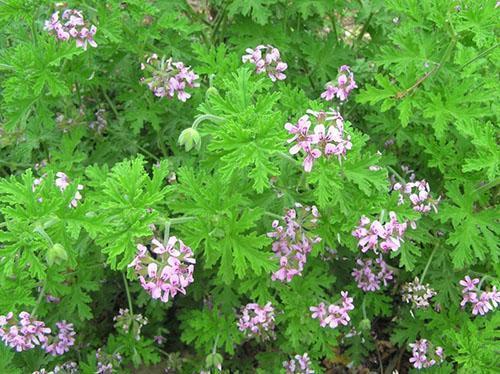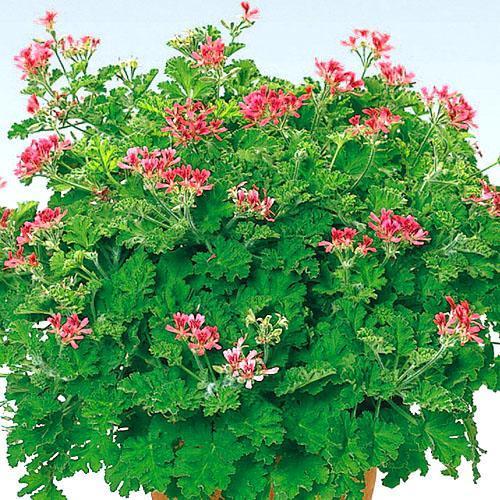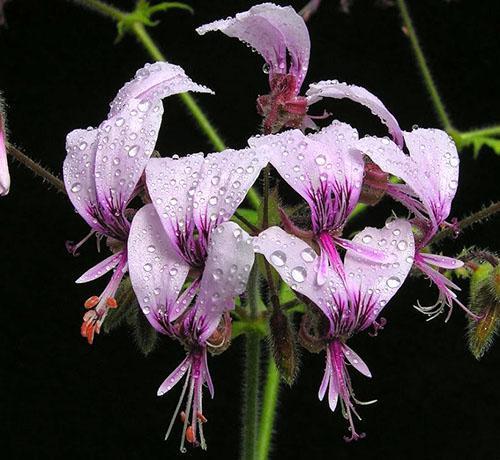We grow fragrant pelargonium at home
 Among the numerous groups of geraniums, fragrant pelargonium occupies a special place. This type of plant does not have a beautiful flowering. But the decorative leaves and the aroma emanating from the plants are remembered with a fleeting touch. The fragrant pelargonium shown in the photo cannot convey the aroma, but it will help to recognize it when you meet.
Among the numerous groups of geraniums, fragrant pelargonium occupies a special place. This type of plant does not have a beautiful flowering. But the decorative leaves and the aroma emanating from the plants are remembered with a fleeting touch. The fragrant pelargonium shown in the photo cannot convey the aroma, but it will help to recognize it when you meet.
The difference between fragrant pelargonium from other species

The glands are the finest hairs, like fluff, growing on the leaf blade and on the stem. The released phytoncides have a detrimental effect on microbes in the room. Sometimes a fragrant plant is called a molar tree, because where the geranium has settled, the moth will not start. The leaves of this flower are used to shift things, putting them away for summer storage.
 The leaves of any variety of fragrant pelargonium themselves are decorative; this type of geranium does not always bloom in indoor conditions. Flowers are small, solitary. But there are varieties strewn with these babies, which gives the impression that butterflies are sitting on the plant. In nature, Pelargonium is a fragrant shrub that reaches more than a meter in height. Therefore, in cultural conditions, the plant seeks to occupy as much space as possible.
The leaves of any variety of fragrant pelargonium themselves are decorative; this type of geranium does not always bloom in indoor conditions. Flowers are small, solitary. But there are varieties strewn with these babies, which gives the impression that butterflies are sitting on the plant. In nature, Pelargonium is a fragrant shrub that reaches more than a meter in height. Therefore, in cultural conditions, the plant seeks to occupy as much space as possible.
In nature and in countries with warm climates, it is an outdoor garden plant. With the help of fragrant pelargonium they arrange hanging gardensdecorate stairs and facades. It is considered appropriate to put a flowerpot with geraniums in spacious, bright rooms.
The essential oil secreted by geraniums is curative and is used in perfumery. Therefore, where the climate permits, scented pelargonium is grown on plantations to obtain essential oil.
How to care for fragrant pelargonium?
 These ornamental plants reproduce easily. It is enough to pinch off the cutting and hold it in water or root it in the ground. If rooting is carried out in the ground, then the cutting should be held in the air for a little while to dry the wound. Then plant in moist soil and cover with a cap for a week. To water soil, if a clod of earth is dry, you can carefully around the glass that covers the new plant.
These ornamental plants reproduce easily. It is enough to pinch off the cutting and hold it in water or root it in the ground. If rooting is carried out in the ground, then the cutting should be held in the air for a little while to dry the wound. Then plant in moist soil and cover with a cap for a week. To water soil, if a clod of earth is dry, you can carefully around the glass that covers the new plant.
This type of pelargonium does not tolerate peat substrates, therefore, the soil mixture is composed of garden soil, sand and humus in equal proportions. Before placing the plant in a pot, you need to make a drainage layer and disinfect the ground. You can plant in a pot a cutting that has taken root, or a bush obtained from seedlings. The main thing is that the roots have enough space, but without excess volume. In a large pot, the plant does not use food, the earth accumulates pathogens, sour, the roots begin to ache.
 A flower pot is arranged in the brightest place. Pelargonium is not afraid of direct sunlight. They can be grown in hanging pots, but with adequate lighting. Watering the plants with moderate top dressing with a small proportion of nitrogen fertilizers. Overfeeding with nitrogen will increase the decorative effect, but the aroma will decrease and may disappear.
A flower pot is arranged in the brightest place. Pelargonium is not afraid of direct sunlight. They can be grown in hanging pots, but with adequate lighting. Watering the plants with moderate top dressing with a small proportion of nitrogen fertilizers. Overfeeding with nitrogen will increase the decorative effect, but the aroma will decrease and may disappear.
 One of the features of this species and proper care is the pinching and pruning of the houseplant. Without this operation, it can turn into an unbranching vine, which, bending randomly, occupies all the space on the window. Therefore, the formation of a bush should be started from the first days of cultivation, achieving branching.
One of the features of this species and proper care is the pinching and pruning of the houseplant. Without this operation, it can turn into an unbranching vine, which, bending randomly, occupies all the space on the window. Therefore, the formation of a bush should be started from the first days of cultivation, achieving branching.
Like any geraniums, fragrant, does not tolerate stagnant water in the soil. Therefore, watering should be moderate without waterlogging. Root rot will destroy the plant. Therefore, it is better to water when the earthy clod dries up. A transplant will be required as soon as the roots fill the pot and emerge from the drainage hole. Early spring is the best time for repotting and strong pruning.
 In conclusion, we will present several photos of fragrant pelargonium, in order to be convinced of the variety of plant forms.
In conclusion, we will present several photos of fragrant pelargonium, in order to be convinced of the variety of plant forms.
 Pelargonium curly in nature is a shrub with woody stems. The leaves have curly edges, are bent down, and smell like lemon. The flowers are small, 2 petals are bent up, three are elongated. It is the basis for many hybrids.
Pelargonium curly in nature is a shrub with woody stems. The leaves have curly edges, are bent down, and smell like lemon. The flowers are small, 2 petals are bent up, three are elongated. It is the basis for many hybrids.
 A gray-haired lady with openwork leaves, from which it is impossible to look away, this is how this rare plant with a jasmine scent appears. It is good even without flowers, but small white-pink inconspicuous flowers give the bush sophistication.
A gray-haired lady with openwork leaves, from which it is impossible to look away, this is how this rare plant with a jasmine scent appears. It is good even without flowers, but small white-pink inconspicuous flowers give the bush sophistication.
 Pelargonium fragrant paniculata is a small bush. The leaves, at the slightest touch, emit the smell of nutmeg, rose mint. Blooms in summer until October. He does not like winter watering, you just need to make sure that the clod of earth does not dry out. Dry air easily tolerates, but requires maximum lighting.
Pelargonium fragrant paniculata is a small bush. The leaves, at the slightest touch, emit the smell of nutmeg, rose mint. Blooms in summer until October. He does not like winter watering, you just need to make sure that the clod of earth does not dry out. Dry air easily tolerates, but requires maximum lighting.
Hello! I cannot find anywhere an explanation for the strange behavior of my fragrant geranium - it releases very long thin threads, entangling the entire bush with them, on which then very small - up to 2 mm - bell buds appear. Is she blooming like that ??? Thank.
If possible, post a photo. You need to see a flower to understand what is happening.
Judging by the photo, dodder has settled on your geranium. The parasitic weed grows from the soil, but after the suckers catch on to the plant, it feeds on its juices. Perhaps the seeds got into the pot along with the soil. We urgently need to rid the geranium of these threads and flowers, otherwise it will die. And at the same time, and change the land - for sure the blooming dodder has already managed to sprinkle seeds. The flower should be removed from the pot and the root system should be well cleaned of soil residues. The roots can be washed in a weak solution of potassium permanganate. It is rather difficult to remove the dodder, as it firmly "eats" into the plant. Therefore, if after transplanting the parasitic weed appears again, it is better to cut off the intact stalk and plant a new geranium.
Hello! Thank you so much for the quick response and your recommendations, now I will start treating my darling. it has a delicious lemon scent. I tried to root the shoot earlier, and dried it, and processed the cut with a rootstock and charcoal, but nothing worked ... I'll try again. THANK !
Sending a photo
Sending photo 2
Sending photo 3